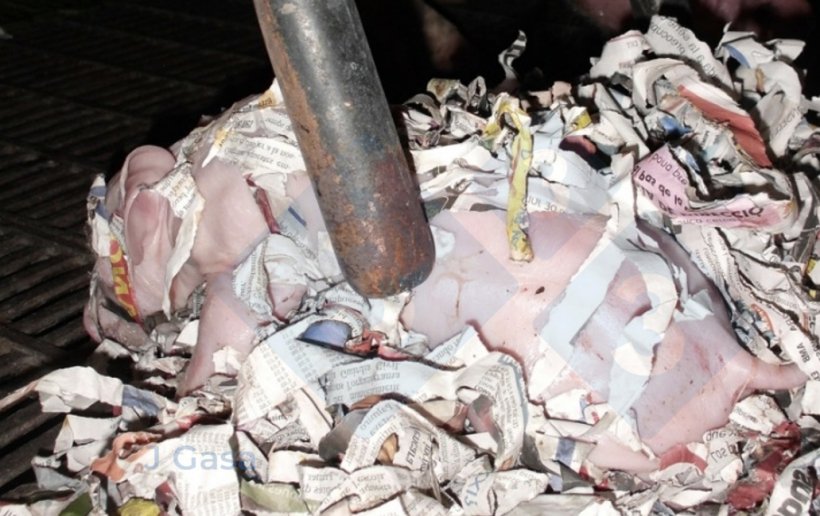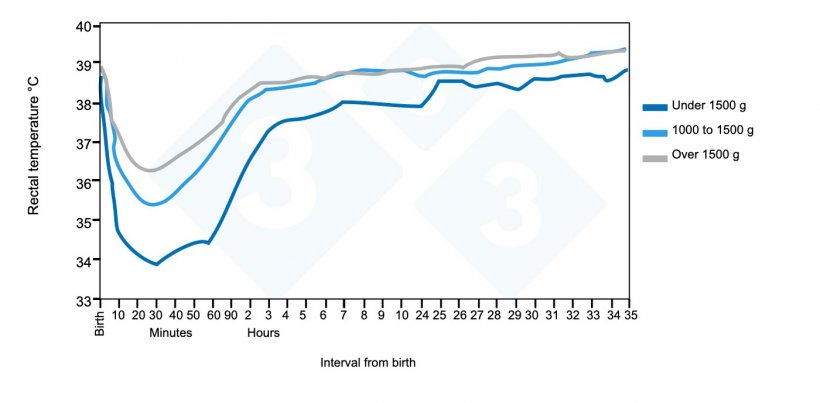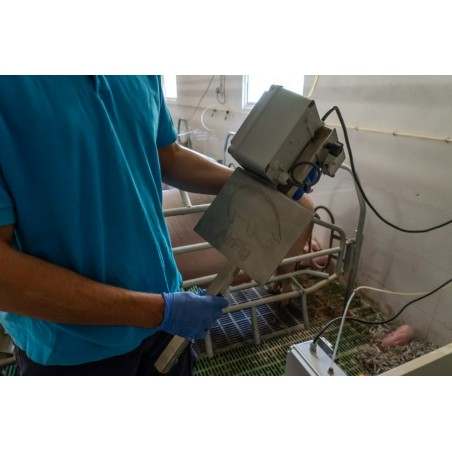Commented article
Vande Pol KD, Tolosa AF, Shull CM, Brown CB, Alencar SAS, Ellis M. Effect of drying and warming piglets at birth on preweaning mortality. Translational Animal Science. 2021; 5(1): txab016. doi: 10.1093/tas/txab016

Academic commentary, by Josep Gasa
The study, although it included the lactations from 800 litters and more than 10,000 piglets, demonstrates the difficulty in obtaining conclusive results when studying husbandry aspects in the farrowing area.
The initial objective is to know the effectiveness of drying and providing supplementary heat to the newborn litter on piglet weaning weight and pre-weaning mortality. Two treatments are used:
- Control
- Experimental (dry the newborn piglet and warm it (36.7 ºC) for 30 minutes).
Piglets were weighed at birth and at weaning, mortality during lactation was recorded, and for 10% of the sows the rectal temperature of their piglets was measured at birth and at 30 minutes. The temperature of the farrowing room was also recorded.
Early results show a higher rectal temperature (+2.33°C) for the experimental treatment at 30 minutes after birth, but no effect on pre-weaning mortality or piglet weaning weight; weaning weight is even numerically somewhat lower for the experimental treatment (5.23 vs. 5.35 kg).
Next, the researchers analyzed two new factors of variation:
a) The litters were distributed into two groups depending on the average environmental temperature of the farrowing room:
- <25 ºC, cool environment
- >25 ºC, warm environment
b) The piglets of each litter were classified into:
- Light (<1.0 kg)
- Medium (1.0 - 1.5 kg)
- Heavy (>1.5 kg)
When reanalyzing the treatment effect (control vs. experimental treatment), the experimental treatment significantly reduced pre-weaning mortality only in the cool environment (14.8% vs. 17.2%) but not in the warm environment (16.2% vs. 15.9%), )while the PDest of the piglet was not affected by the experimental treatment and was higher in the temperate environment than in the hot environment (5.77 vs 4.98). . These results would indicate that experimental treatment favors piglet survival in the hours/days after farrowing only in farrowing rooms with moderate or suboptimal temperatures (<25 °C), while a higher temperature (>25 °C) in the farrowing room would impair piglet growth.
Finally, the authors indicate that the factor that most affects both pre-weaning mortality and the weaning weight of piglets is their live weight at birth. Regardless of treatment, preweaning mortality varied between 44.6% and 8.2% for light and heavy piglets and weaning weight was 3.73 kg vs. 5.86 kg for light and heavy piglets, respectively.
In short, the extra labor of drying and giving supplemental warmth to newborn piglets would only be advisable on farms with low piglet birth weights, which is very common in hyperprolific sows, and in farrowing rooms that are at suboptimal temperatures around the time of farrowing; this may be the case on many farms in the winter, bearing in mind that the experiment was conducted in Indiana (USA) between April and November 2018.
On-farm commentary, by Josep Casanovas
This is a very interesting study that tries to shed light on management practices that we have always considered indispensable.
There are two types of mammals, those that are fully developed when they are born and already have a certain degree of independence, such as calves, lambs, etc., and those that are not fully developed when they are born, such as humans, mice, cats, dogs, etc.
Female mammals that give birth to young that are not fully developed need a nest, which will simulate intrauterine environmental conditions until their offspring are fully developed.
Which category do pigs fall into?
Piglets are not completely independent when they are born; they need about 3 days to finish developing and become relatively independent.
Two very different types of animals are housed in the farrowing room; sows that weigh over 220 kg and piglets that weigh between 1 and 10 kg.

Animals with different characteristics have different environmental needs. Piglets housed in the farrowing room need a nest, a resting area where the temperature should be around 30ºC during the first week of life.
In mammals, parturition is a critical time for the survival of both mother and offspring.
At parturition, the offspring's thermoregulation mechanisms will start for the first time, but this occurs at a time when they have no energy reserves.
To facilitate parturition, the young are born extremely thin, without fatty tissue, in order to be able to pass through the birth canal with the least amount of difficulty. Fat tissue is the storehouse of energy reserves.
Most female mammals lick their young after birth to dry them and stimulate them to start suckling.
Colostrum, in addition to being full of antibodies to protect the offspring from possible infectious problems, is loaded with energy sources so that the piglet starts to recover energy as soon as possible.
Drying and colostrum intake are key to ensuring the survival of the newborn.
The sow does not lick her piglets when they are born because she is incapable of doing so. The size difference would favor crushing. The sow doesn't have the same ability as bitches have to reach her hindquarters with her snout.
In the last century, more than 40 years ago, Peter English carried out different measurements of rectal temperature in newborn piglets in the first hours after birth. The results, of course, are very similar to those of the present study. Figure 2. Rectal temperature trends from birth to 35 hours of age in relation to weight group at birth. Source: Pattison, English, MacPherson, and Birnie 1989.
At birth, the piglets have a rectal temperature of around 38.7 ºC. This is logical since this is the normal temperature of a sow, and of a pig.
Thirty minutes after farrowing, piglets that do not receive any treatment have a rectal temperature of 35.65 ºC (3 ºC less than the normal temperature of a pig), compared to 37.98 ºC (0.7 ºC less) for piglets that are dried and placed under a heat source.
Three degrees is a lot. Imagine that one day you take your body temperature and it reads 33.7 ºC instead of 36.7 ºC.
What would you do in this situation? I'm sure you would be quite worried.
I think there are a couple of important limitations in the present research study.
On the one hand, the half-hour of offering the piglets heat without access to colostrum seems too long for me, and on the other hand, the temperature of the "warming" area was probably too high. The data provided by the study says it was 37.1 +/- 3.22 ºC under the heat source when 34 ºC probably would have been sufficient.
In the days when weaning more than 10 piglets per litter was a challenge, using newspaper in the first days after farrowing meant gaining one more weaned piglet. Newsprint was used to dry the piglets and as bedding, insulating them from the floor and improving the thermal sensation where the piglets rested by a couple of degrees.
In view of the study, it is worthwhile to dry the piglets even for "altruistic" reasons, in order to ensure their well-being, so that they can recover their body temperature as quickly as possible..
Summary of commented articleVande Pol KD, Tolosa AF, Shull CM, Brown CB, Alencar SAS, Ellis M. Effect of drying and warming piglets at birth on preweaning mortality. Translational Animal Science. 2021; 5(1): txab016. doi: 10.1093/tas/txab016 Methods: This study evaluated the effect of drying and warming piglets at birth on preweaning mortality and weaning weight under commercial conditions. A completely randomized design was used with 802 sows/litters (10,327 piglets); sows/litters were randomly allotted at the start of farrowing to one of two Intervention Treatments (applied at birth): Control (no drying or warming); Drying+Warming (dried with a cellulose-based desiccant and placed in a box under a heat lamp for 30 min). Piglets were weighed at birth and weaning; preweaning mortality was recorded. Rectal temperature was measured at 0 and 30 min after birth on all piglets in a subsample of 10% of litters. The effect of farrowing pen temperature on weaning weight and preweaning mortality was evaluated by comparing litters born under COOL (<25°C) to those born under WARM (≥25°C) farrowing pen temperature. The effect of birth weight on weaning weight and preweaning mortality was evaluated by comparing three birth weight categories (Light: <1.0 kg, Medium: 1.0 to 1.5 kg, or Heavy: >1.5 kg). PROC GLIMMIX and MIXED of SAS were used to analyze mortality and other data, respectively. Litter was the experimental unit; piglet was a subsample of litter. The model included fixed effects of Intervention Treatment, and farrowing pen temperature or birth weight categories as appropriate, the interaction, and the random effects of litter. Results: Piglet rectal temperature at 30 min after birth was greater for the Drying+Warming than the Control treatment (+2.33°C). Overall, there was no effect of Intervention Treatment on preweaning mortality or weaning weight, and there were no Intervention Treatment by birth weight categories interactions for these measurements. There was an Intervention Treatment by farrowing pen temperature interaction for preweaning mortality. Drying and warming piglets reduced preweaning mortality under COOL (by 2.4 percentage units) but not WARM farrowing pen temperature. In addition, weaning weights were lower under WARM (by 0.79 kg) than COOL farrowing pen temperature; however, there was no interaction with Intervention Treatment. Conclusion: This study suggests that drying and warming piglets at birth increases rectal temperature and may reduce preweaning mortality under cooler conditions, which are typically experienced in temperate climates during the majority of the year. |






